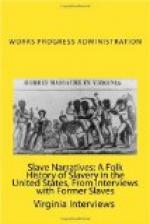“And another thing I can tell you. In the spring of the year we was hoein’ and when they quit at night they’d leave the hoes in the field, stickin’ down in the ground. And next morning they wouldn’t be where you left ’em. You’d have to look for ’em and they’d be lyin’ on top of the ground and crossed just like sticks.
“I’ll tell you what I do know. When we was livin’ in Conway County old man Powell had about ten colored families he had emigrated from Jefferson County. Our folks was the only colored people in that neighborhood. And he had a white man that was a tenant on the place and he died. Now my mother and his wife used to visit one another. In them days the white folks wasn’t like they are now. And so mother went there to sit up with his wife. And while she was sittin’ up the house was full of people—white and colored. They begin to hear a noise about the coffin. So they begin to investigate the worse it got and moved around the room and it lasted till he was took out of the house. Now I’ve heard white and colored say that was true. They never did see it but they heard it.
“I don’t think there is any ghosts now but they was in the past generation.
“I know many times me and my stepfather would be pickin’ cotton and my dog would be up at the far end of the row and just before dark he’d start barkin’ and come towards us a barkin’ and we never could see anything. He’d do that every day. It was a dog named Natch—an English bull terrier. He was give to me a puppy. He was a sure enough bulldog and he could whip any dog I ever saw. He was an imported dog.
“I remember a house up in Conway County made out of logs—a two-story one just this side of Cadron Creek on the Military Road. Then they called it the Wire Road because the telegraph wire run along it. The house was vacant after the people that owned it had died, and people comin’ along late at night would stop to spend the night, and in the middle of the night they’d have to get out. Now I’ve heard that with my own ears. There was a spring not far from the house. It had been a fine house and was a beautiful place to stop. But in the night they’d hear chairs rattlin’ and fall down. It’s my belief they had spooks in them old days.
“Now I’ll tell you another incident. This was in slave times. My mother was a great hand for nice quilts. There was a white lady had died and they were goin’ to have a sale. Now this is true stuff. They had the sale and mother went and bought two quilts. And let me tell you, we couldn’t sleep under ’em. What happened? Well, they’d pinch your toes till you couldn’t stand it. I was just a boy and I was sleepin’ with my mother when it happened. Now that’s straight stuff. What do I think was the cause? Well, I think that white lady didn’t want no nigger to have them quilts. I don’t know what mother did with ’em, but that white lady just wouldn’t let her have ’em.
“Now I’m puttin’ the oil out of the can—I mean that what I say is true. People now will say they ain’t nothin’ to that story. At that time the races wasn’t ’malgamated. But people are different now—ain’t like they was seventy-five years ago.




